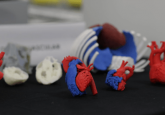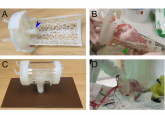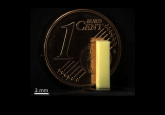3DMedNet quiz of the year: the year in 3D printing for medicine

To celebrate the 2019 festive season, 3DMedNet has launched the ‘quiz of the year’! Join us as we ask questions surrounding basic 3D printing trivia, highlights from medical 3D printing news headlines in 2019 and projects to watch in 2020.
To celebrate the 2019 festive season, 3DMedNet has launched the very first, ‘quiz of the year’!
Over the next few weeks, we will be asking five questions on our social media channels surrounding 3D printing trivia, highlights from medical 3D printing news headlines in 2019 and projects to watch in 2020. You can join us via this post, Twitter, Instagram, Facebook and LinkedIn each week for the answer to each question. Please comment or reply to our threads with your answers, but NO GOOGLE!
We will be posting the answers here each week, along with our highlights from 2019 and exclusive access to some of our top content, so make sure you keep up with our weekly updates!
 |
 |
 |
 |
 |
Question 1: when was 3D printing invented?
…and for bonus points: what was the first ever 3D-printed object?
Answer
The answer is that 3D printing actually outdates the internet! In 1981, Hideo Kodama of Nagoya Municipal Industrial Research Institute (Japan) proposed the first 3D printing system in a research paper, but it was Chuck Hull of 3D Systems (SC, USA) who 3D printed the first ever ‘part’ in 1983, later called ‘stereolithography’ in a 1984 patent application. The first object ever printed, was an eye wash cup.
In 2019, 36 years later, 3D printing technologies have advanced so far that scientists are bioprinting corneas, retinas and other components of the eye!
From 3D printing the eye cup, to the eye:
Question 2: in how many dimensions is it possible to print?
Answer
We should all be familiar with 2D and 3D printing by now, but it is actually possible to print in further dimensions. With the fourth ‘dimension’ being time, 4D-printed objects have the propensity to change after being printed. In theory, it could be possible to print devices for drug delivery which change state at internal body temperature.
It is also possible to print on the fifth dimension, printing from 5 axes. 5D printing could allow for curved layers and stronger end products using fewer materials.
Further dimensions do exist in physics and literature, but unless you’re keen to discuss 6D printing as ‘the combined use of telekinesis with 3D printing’, I think we’ll leave this one here for now.
Printing in the fourth dimension:
Question 3: how much time, on average, have surgeons reported they can save by employing 3D printing technologies?
Answer
The answer actually ranges from 27—40% depending on the procedure, but it’s not just time that surgeons are saving. In an interview with Juling Ong, Consultant Plastic Surgeon at Great Ormond Street Hospital in London (UK), we learned that 3D printing also reduced bleeding and risk when performing a complex conjoined twins separation procedure. We also heard from many surgeons at 3DMedLIVE this year, as we came together to convene the community of innovation and best practice of surgical 3D printing.
You can catch up on our highlights from 3DMedLIVE 2019 here, and can register your interest for 2020 via www.3dmedlive.com
Read more about surgical 3D printing in our Editor’s picks from this year:
-
Innovative, 3D-printed surgical solutions: from patient to pioneer
-
The current landscape of 3D printing in oncological surgical interventions
Question 4: how far away are we from 3D-printed organs?
Answer
Unfortunately, there is no definitive answer to this question and we still appear to be a long way off. However, we are definitely making progress and have seen some incredible advances in the 3D printing of vascularized skin, moving, ‘breathable’ lung tissue and even semi-functional ‘human’ hearts.
Find out more about some of our top stories in bioprinting with our Editor’s picks:
- Vascularized heart 3D printed utilizing patient’s own cells and biological materials
- Novel, ‘SWIFT’ technique for 3D printing organs
- Implantable blood vessels 3D printed from human cells
- Bioprinting a miniature human heart
- Vascularized, living skin 3D printed for skin grafts and wound healing
- Breathtaking bioprinting: ‘breathing’ lung model 3D printed
- 3DMedTALKS l 3D printing for spinal cord injury research
Question 5: how many areas of medicine can you name that are already benefitting from 3D printing technologies?
Answer
The answer is pretty much infinite, but one area of specialism which has arguably seen the most adoption, is oncology. This year, 3DMedNet led the first ‘3D in focus’ feature investigating the use of 3D printing in the field of oncology with help from experts around the world. We have also had the pleasure of teaming up with our sister website, Oncology Central, to bring you exclusive patient perspective stories and features.
Check out some of our top oncology content from 2019:
- Applications in oncology
- 3D printing in radiation oncology: where are we now?
- 3DMedTALKS l 3D printing and patient experience with surgery
- 3D-printed drug delivery system stops cancer in its tracks
- Applications of 3D printing in oncology: tools for radiation therapy
- Applications of 3D printing in oncology: solutions for orthopedic oncology surgeries
Unfortunately, this marks the end of our 3DMedNet quiz of the year. Thank you to everyone who played along — we hope you enjoyed this quiz as much as we did!
I would like to take this opportunity to thank all our members, contributors and experts for working with us this year with both 3DMedNet and of course, 3DMedLIVE. I look forward to working with you all on even more features and great content in 2020. Happy New Year!





